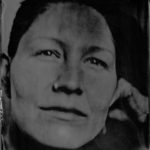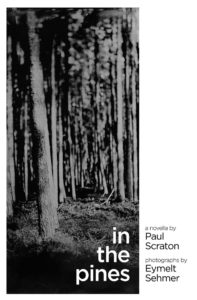Book Review – January 2022
What else lives here, among these trees? You recall the stories, your father’s gentle voice. There was no need to shout in the forest, he said, as he explained all the living beings that surround you. Just because we’ve never seen them, he said, doesn’t mean they’re not here. After all, what happens to things when we discover them? The hunters’ pulpits were evidence enough of that. Why would you show yourself, if to show yourself was to issue your own death sentence?
With In the Pines Paul Scraton presents us with a strange, brooding collection of literary fragments. They are drawn together by an unnamed narrator and haunted by the ever-present forest that dominates the narrator’s life. We are not given the name of the forest, nor is it made clear in what country Scraton’s stories unfold. Neither are we given the name of the narrator and even their gender is left unclear. Although, in a German magazine interview, Scraton refers to them as ‘she’ and ‘her’. We are being led, perhaps, to concentrate our attention on the story rather than the storyteller.
I’m going where the cold wind blows
In the pines, in the pines *
The viewpoint of the central narrative switches regularly from the first person to the third, often within the same fragment. The only constant is the forest; its presence underpins everything. The forest, of course, is integral to the German imagination, to that nation’s sense of itself; and Germany is where Scraton has made his home. But he deliberately avoids suggesting Germany is the location of In the Pines, as if to stress the universality of his themes. In doing so he has created a work of great imagination and verve.
Integral to the book is the black and white photography of Eymelt Sehmer. She uses a photographic technique called the collodion wet plate process. This requires a black tin plate to be coated, sensitized, exposed and developed in the space of about fifteen minutes. Before working on In the Pines this was a technique she only used in the studio, so Sehmer’s greatest challenge was to construct a mobile dark room and drag it into the forest with her and Scraton. The result is a series of startling, ghostly images.
Sehmer’s images are at once crystal clear and at the same time disorientatingly hazy. The imperfections created by the analogue process serve to heighten the sense of the uncanny in her compositions. Gazing at each image, one finds one’s imagination seeing things that are not really there. In a very visceral sense, these pictures bring the text to life.
For Scraton’s narrator the forest is always there, a brooding presence. But it is also a metaphor for something else. In The Divine Comedy, Dante’s narrator describes the ‘dark wood’ as a period of pain and loss in his life:
I was in the middle of my life when I found myself in a
dark wood, for I no longer knew the way **
In the human imagination the forest is the stuff of fairy tales and nightmares, the home of wolves and witches. It is also a place of life and renewal. And yet, with our roads and factory farms, we persist in razing it; destroying trees, destroying the land, destroying our climate. But the forest, Scraton seems to suggest, is capable of restoring itself and will no doubt do so when the age of human dominance has passed.
* Traditional American folk song, now best known for its incorporation into Nirvana’s Where Did You Sleep Last Night
** Translated by Kathy Acker, 1986
Paul Scraton
 Is a Lancashire-born writer and editor based in Berlin. Paul is the editor-in-chief of Elsewhere: A Journal of Place and the author of Ghosts on the Shore: Travels Along Germany’s Baltic Coast (Influx Press, 2017) and the novel Built on Sand (Influx Press, 2019). His essays on place and memory have been published as the pocket book The Idea of a River: Walking out of Berlin (Readux Books, 2015), and in Mauerweg: Stories from the Berlin Wall Trail (Slow Travel Berlin, 2014).
Is a Lancashire-born writer and editor based in Berlin. Paul is the editor-in-chief of Elsewhere: A Journal of Place and the author of Ghosts on the Shore: Travels Along Germany’s Baltic Coast (Influx Press, 2017) and the novel Built on Sand (Influx Press, 2019). His essays on place and memory have been published as the pocket book The Idea of a River: Walking out of Berlin (Readux Books, 2015), and in Mauerweg: Stories from the Berlin Wall Trail (Slow Travel Berlin, 2014).
Eymelt Sehmer
Is a Berlin-based p rofessional photographer, artist and filmmaker. Growing up in a densely wooded area in West Germany the forest always fuelled her imagination. In her works she mainly focuses on mythology, fairy tales and folklore. She is particularly interested in old analogue photographic techniques. Together with Icelandic artist Mr. Arnarson she runs an art gallery and photo studio in Berlin.
rofessional photographer, artist and filmmaker. Growing up in a densely wooded area in West Germany the forest always fuelled her imagination. In her works she mainly focuses on mythology, fairy tales and folklore. She is particularly interested in old analogue photographic techniques. Together with Icelandic artist Mr. Arnarson she runs an art gallery and photo studio in Berlin.



In medieval Europe the words for forest were synonymous with ‘desert’ – meaning uninhabited and therefore wild and frightening. Now we probably think the opposite
I can see why they would say that. On the other hand (lousy joke alert), in 1970s Britain the words black forest were synonymous with over-sweetened ‘dessert’!
Ordered The Pines, Bobby. That’s 3 of your recommendations bought this year. Currently reading The Ice Palace and enjoying it a lot.
Cheers, Sandy
Thanks Sandy. I think I must be one of Influx Press’s most enthusiastic customers!
Wow, that sounds an unsettling one (I am always worried about getting lost in forests, and have done, in fact, in the past, even clutching a map and having a geography a-level!).
I agree it’s quite easy to get lost in a forest without any obvious landmarks to navigate by and one stand of trees looking pretty much like another. I’ve just finished Bill Bryson’s ‘A Walk in the Woods’ on audio and he had similar problems!